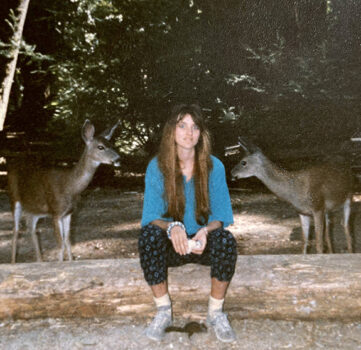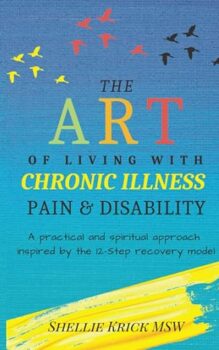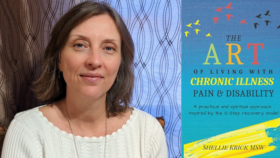BAL Spotlights Series
In her book, The Art of Living With Chronic Illness, Pain, and Disability: A Practical and Spiritual Approach Inspired by the 12-Step Recovery Model, author, and former social worker Shellie Krick, explores how she used the 12-step Al-Anon program as a template to cope with her Lyme disease. Shellie has experienced over 30 years of chronic health problems stemming from Lyme and Bartonella infections, misdiagnosis, and dangerous, unproven treatments—some of which caused serious harm. Her book stems from her personal journey, offering a step-by-step guide to developing a different way of handling daily life with a chronic illness or chronic pain.
“I definitely wasn’t the type of person who liked sitting around doing nothing—Lyme has been really hard on me in that way. But through my book, if I can help just one person cope with their situation better, then I will feel I have accomplished a lot.”
– Shellie Krick
 In the late 1980s, Shellie Krick was a dynamic, politically engaged, healthy young woman in her 20s, living in San Francisco. She was extremely involved in activism around the HIV/AIDS community in the city, planned to be a social worker, and loved getting out into nature for adventures with friends. Around 1988 or ‘89, Shellie went on a camping trip to Big Basin. She has no recollection of being bitten by a tick, but shortly after the trip began to experience severe dizzy spells and flu-like symptoms.
In the late 1980s, Shellie Krick was a dynamic, politically engaged, healthy young woman in her 20s, living in San Francisco. She was extremely involved in activism around the HIV/AIDS community in the city, planned to be a social worker, and loved getting out into nature for adventures with friends. Around 1988 or ‘89, Shellie went on a camping trip to Big Basin. She has no recollection of being bitten by a tick, but shortly after the trip began to experience severe dizzy spells and flu-like symptoms.
Over many years up until its closure from the wildfires of 2020, Big Basin State Park had been a popular destination for camping, hiking, and enjoying nature. The varied terrain of redwoods, trails, creeks, Santa Cruz mountains, and breath-taking scenic hikes offers some of the most beautiful and accessible outdoor adventures for residents of the San Francisco Bay Area and beyond. But, back in the late ‘80s and early ‘90s, it was not unusual for people to feed animals in parks. “Looking back on it now, I fed and petted deer on that trip. I have pictures of it, but at the time I didn’t think anything of it,” she recalls.
Like many people who go on to develop Lyme disease, Shellie never saw the tick that bit her, and never saw a rash of any kind. “Of course, I found out later that a lot of people don’t get bullseye rashes and that even teeny tiny baby ticks can infect you – they’re so small that you might not notice.”
At the time, Shellie’s boyfriend used to make fun of her because she was an insect magnet, always getting bitten by something when they were out in nature. “It was a running joke with us because he never got bitten. For my whole life, I’ve always gotten bitten by things very easily. And I don’t know why they like my blood. So, it could have been some tiny ticks that I thought were flea bites, or mosquito bites.”
Over the months following the camping trip, Shellie felt sicker and sicker, and her doctors had no idea what was wrong or how to treat her. As her health declined, she struggled to maintain her independence and had to move back in with her parents. They sent her to see their own doctor, who tested Shellie for Lyme—but the test came up negative. “Soon after this, I became completely disabled,” she explains. “Eventually, my parents found a doctor who diagnosed me with chronic fatigue syndrome (ME/CFS).”
CFS was her diagnosis for many years and the only treatments that seemed to help at all were those offered outside of conventional medicine. For an extended period of about a decade, Shellie managed her symptoms using a combination of acupuncture, chiropractors, massage therapists, and naturopathic providers.
Although after about 10 years, Shellie describes that she had gotten “moderately better,” she was still far from the healthy, active young woman of her 20s. She decided to go to a clinic in Nevada that was supposed to treat people with difficult conditions like chronic fatigue. She received daily homeopathic IV treatments, adrenaline shots, and was put on an extremely restricted diet. However, things did not go according to plan.
“I got so much worse. I was at the clinic on and off for six months, but the treatments led to a terrible physical collapse. I later learned that the clinic was closed down by the FDA because the ‘doctors’ on staff were not licensed to practice medicine in the US. I’ve never really been the same since then. That experience and the ‘treatments’ I was given really demolished me.”
 A few years later, Shellie started seeing another doctor who tried many different approaches to try and restore her health. Nothing worked. However, Shellie got a lucky break. The doctor attended a conference about Lyme disease and on his return told her, “The people at the conference were describing you!” He ordered a suite of new tests from iGenex and she finally tested positive for Lyme disease.
A few years later, Shellie started seeing another doctor who tried many different approaches to try and restore her health. Nothing worked. However, Shellie got a lucky break. The doctor attended a conference about Lyme disease and on his return told her, “The people at the conference were describing you!” He ordered a suite of new tests from iGenex and she finally tested positive for Lyme disease.
Despite the relief of finally having a diagnosis, Shellie did not respond well to antibiotic treatment. So, eventually, she found functional medicine doctors and finally began to make progress. More recently, with new treatment options at the California Center for Functional Medicine (founded by Sunjya Schweig, MD, member of Bay Area Lyme Foundation’s Scientific Advisory Board), Shellie has discovered that she not only has Lyme, but also Bartonella, mycotoxins from mold exposure, and gut issues. She’s optimistic about her situation: “It’s been a very comprehensive and intensive and exhausting process because there’s a lot that you need to do. I have three people that work with me. It’s a team approach, but I’m grateful for it. So, I’m hopeful that maybe a couple years from now my life might be in a different place.”
“If you’re not afraid to try some new things and be vulnerable while you’re trying them for the first time, a person may find it’s just a better, calmer way to get through the day.”
– Shellie Krick talking about her new book
Despite and because of being so ill for so long, Shellie decided that she wanted to leverage her experience and develop something positive from her personal Lyme journey. Shellie had been a member of Al-Anon for many years. She found a new sponsor who, after a few conversations, pointed out to Shellie that her biggest challenge was her own health, and had she considered applying the 12-step approach to her health struggles?
Initially, Shellie was skeptical. “I thought, ‘Oh no! One more chore to do!’ ” But then she started to apply the steps to her health and little by little started to feel calmer. “My physical health was still not good, but my mental health was so much better. I wasn’t as stressed out all the time and I felt like I wasn’t alone.”
In Al-Anon, there is a strong spiritual element to the 12-step program. Participants don’t have to be religious, but there is the concept of turning over the things that we cannot control to a ‘higher’ power—in essence a device to help us understand the things that we can control versus those things that we cannot control. Shellie explains how she started using this concept to help her manage her ongoing challenges with her health:
“I really had connected my higher power to giving me strength when I needed it. I reflected on how that program had helped with my health, and I thought maybe it would help someone else. I thought, ‘I’m just going to start writing and see what happens.’ My energy level has always been limited so it was a very slow process. Sometimes months and months would go by and then I’d look back and go, ‘Oh gosh, I wrote all the way through step four. I guess I’ll keep doing it.’ So it was kind of on and off again—especially when my parents were dying.”
Shellie didn’t work on her book for very long periods of time, but she would always come back to it. She liked having a project because being a former social worker, she wanted to be of service to others. The book was a project where she hoped it would help someone else someday. And after a number of years, she finally finished it.
“There are some days—and I even say this in the book—where I’ve had a horrible time and it’s just been too much. I need to be miserable for a while. But overall, a lot of my practice and the steps that I outline in the book are now second nature.”
Shellie had a friend who had some publishing experience and they decided she should try to self-publish rather than try to get a publishing agency to do it. “It took a lot out of me, to be honest, to do all of that and get it published. I don’t think I could have done it without my friend’s help. By the time I had the first draft, my friend read it and said: ‘I think this could be helpful, I think you should really pursue this.’ It has taken years for me to get the book out there, but if chronically ill patients pick it up and it helps them, I’m happy.”
Shellie describes the book as a step-by-step program that can guide a person through a different way of handling their daily life with a chronic illness or chronic pain. The concept of reliance on a higher power is designed to take the weight off a person’s shoulders. She says, “It makes you feel like you don’t have to try to figure everything out when you can’t.”
 The book is probably more helpful and effective for readers who are open-minded about a higher power, or that have some kind of spiritual belief system, or are interested in finding that, as this is the basis of any 12-step program. The book features a lot of examples of ways of coping with chronic illness and chronic pain. Shellie notes, “If you’re not afraid to try some new things and be vulnerable while you’re trying them for the first time, a person may find it’s just a better, calmer way to get through the day.”
The book is probably more helpful and effective for readers who are open-minded about a higher power, or that have some kind of spiritual belief system, or are interested in finding that, as this is the basis of any 12-step program. The book features a lot of examples of ways of coping with chronic illness and chronic pain. Shellie notes, “If you’re not afraid to try some new things and be vulnerable while you’re trying them for the first time, a person may find it’s just a better, calmer way to get through the day.”
Even for Shellie, daily practice of her own program is not always easy. “There are some days—and I even say this in the book—where I’ve had a horrible time and it’s just been too much. I need to be miserable for a while. But overall, a lot of my practice and the steps that I outline in the book are now second nature. I find myself thinking in a more positive way, writing down things that I’m worried about or concerned about and putting them in a ‘God box.’ Then I can just let it go, because I’ve done my part.”
Because of her health journey and struggles with Lyme disease, Shellie has been unable to work for most of the last 30 years, volunteering periodically when she has had small pockets of energy. For her, writing this book is a way of being active in and giving back to the Lyme community. “I definitely wasn’t the type of person who liked sitting around doing nothing—Lyme has been really hard on me in that way. But through my book, if I can help just one person cope with their situation better, then I will feel I have accomplished a lot.”
Shellie’s book is The Art of Living With Chronic Illness, Pain, and Disability: A Practical and Spiritual Approach Inspired by the 12-Step Recovery Model. You can buy it on Amazon here.
This blog is part of our BAL Spotlights Series. Bay Area Lyme Foundation provides reliable, fact-based information so that prevention and the importance of early treatment are common knowledge. For more information about Bay Area Lyme, including our research and prevention programs, go to www.bayarealyme.org.

A wonderful interview about a wonderful person and book.